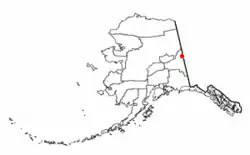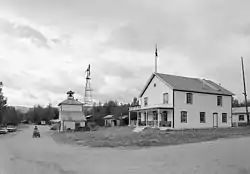Eagle, Alaska
Eagle (Tthee T’äwdlenn in Hän Athabascan[4]) is a city on the south bank of the Yukon River near the Canada–US border in the Southeast Fairbanks Census Area, Alaska, United States. It includes the Eagle Historic District, a U.S. National Historic Landmark. The population was 86 at the 2010 census. Every February, Eagle hosts a checkpoint for the long-distance Yukon Quest sled dog race.[5]
Eagle, Alaska
Tthee T’äwdlenn | |
|---|---|
 Steamer Hannah at Eagle landing, circa 1900 | |
 Location of Eagle, Alaska | |
| Coordinates: 64°47′15″N 141°12′5″W | |
| Country | United States |
| State | Alaska |
| Census area | Southeast Fairbanks |
| Incorporated | February 9, 1901[1] |
| Government | |
| • Mayor | Daniel Helmer |
| • State senator | Click Bishop (R) |
| • State rep. | Dave Talerico (R) |
| Area | |
| • Total | 0.88 sq mi (2.28 km2) |
| • Land | 0.88 sq mi (2.28 km2) |
| • Water | 0.00 sq mi (0.00 km2) |
| Elevation | 853 ft (260 m) |
| Population (2010) | |
| • Total | 86 |
| • Estimate (2019)[3] | 83 |
| • Density | 94.21/sq mi (36.36/km2) |
| Time zone | UTC-9 (Alaska (AKST)) |
| • Summer (DST) | UTC-8 (AKDT) |
| ZIP code | 99738 |
| Area code | 907 |
| FIPS code | 02-20380 |
| GNIS feature ID | 1401499 |
Geography
Eagle is located at 64°47′10″N 141°12′0″W (64.786022, -141.199917).[6]
Eagle is on the southern bank of the Yukon River, 8 miles (13 km) west of the border between Alaska and the Yukon Territory of Canada at the end of the Taylor Highway, near Yukon–Charley Rivers National Preserve.
According to the United States Census Bureau, the city has a total area of 1.0-square-mile (2.6 km2), all land.
Climate
Like most of Alaska, Eagle has a subarctic climate (Köppen Dfc) with long, cold winters occasionally moderated by chinook winds, and short, warm summers. In the absence of chinook moderation, winter temperatures can be dangerously cold: in the notoriously cold month of December 1917, the temperature did not rise above −25 °F or −31.7 °C and it averaged −46 °F or −43.3 °C.[7] When chinooks occur, winter temperatures can get above 32 °F or 0 °C, doing so on an average of five days per winter.
| Climate data for Eagle | |||||||||||||
|---|---|---|---|---|---|---|---|---|---|---|---|---|---|
| Month | Jan | Feb | Mar | Apr | May | Jun | Jul | Aug | Sep | Oct | Nov | Dec | Year |
| Record high °F (°C) | 50 (10) |
51 (11) |
53 (12) |
74 (23) |
91 (33) |
97 (36) |
93 (34) |
93 (34) |
80 (27) |
69 (21) |
51 (11) |
47 (8) |
97 (36) |
| Average high °F (°C) | −3.9 (−19.9) |
5.6 (−14.7) |
21.8 (−5.7) |
42.3 (5.7) |
59.2 (15.1) |
71 (22) |
72.9 (22.7) |
66.9 (19.4) |
53.9 (12.2) |
32.3 (0.2) |
11.4 (−11.4) |
1.4 (−17.0) |
36.2 (2.3) |
| Average low °F (°C) | −21.5 (−29.7) |
−16.6 (−27.0) |
−8.2 (−22.3) |
14.4 (−9.8) |
31.9 (−0.1) |
43.9 (6.6) |
47.1 (8.4) |
41.1 (5.1) |
30.7 (−0.7) |
15.1 (−9.4) |
−5 (−21) |
−15.6 (−26.4) |
13.1 (−10.5) |
| Record low °F (°C) | −71 (−57) |
−67 (−55) |
−58 (−50) |
−30 (−34) |
1 (−17) |
23 (−5) |
28 (−2) |
18 (−8) |
−7 (−22) |
−37 (−38) |
−54 (−48) |
−69 (−56) |
−71 (−57) |
| Average precipitation inches (mm) | 0.53 (13) |
0.43 (11) |
0.34 (8.6) |
0.31 (7.9) |
0.96 (24) |
1.67 (42) |
2.29 (58) |
1.96 (50) |
1.22 (31) |
0.94 (24) |
0.69 (18) |
0.7 (18) |
12.04 (306) |
| Average snowfall inches (cm) | 7.8 (20) |
6.9 (18) |
5.1 (13) |
3.1 (7.9) |
0.9 (2.3) |
0 (0) |
0 (0) |
0 (0) |
0.8 (2.0) |
9.4 (24) |
10.9 (28) |
11.3 (29) |
56.2 (143) |
| Average precipitation days | 6 | 5 | 4 | 3 | 7 | 10 | 13 | 12 | 9 | 8 | 7 | 7 | 91 |
| Source: [8] | |||||||||||||
History
For thousands of years, the Eagle area was the home to indigenous peoples, including the historic Han people since long before the arrival of Europeans in Alaska.
The first permanent American-built structure in present-day Eagle was a log trading post called "Belle Isle", built around 1874. In the late 1800s, Eagle became a supply and trading center for miners working the upper Yukon River and its tributaries. By 1898, its population had exceeded 1,700, as people were coming into the area because of the Klondike Gold Rush.
In 1901 Eagle became the first incorporated city in the Alaska Interior. It was named for the many eagles that nested on nearby Eagle Bluff. A United States Army camp, Fort Egbert, was built at Eagle in 1900. A telegraph line between Eagle and Valdez was completed in 1903. In 1905, Roald Amundsen arrived in Eagle and telegraphed the news of the Northwest Passage to the rest of the world.
The gold rushes in Nome and Fairbanks lured people away from Eagle. In 1903 Judge James Wickersham moved the Third Division court from Eagle to Fairbanks. By 1910, Eagle's population had declined to its present-day level (below 200 people). Fort Egbert was abandoned in 1911.
Present-day Eagle is home to mostly people of European descent. Nearby Eagle Village has a small population that is about 50 percent Han.
The town enjoyed some notoriety as the setting of John McPhee's book Coming into the Country, which was first published in 1977 and became quite popular. Many of the buildings from the Gold Rush years are preserved as part of the Eagle Historic District, a National Historic Landmark district.

Demographics
| Historical population | |||
|---|---|---|---|
| Census | Pop. | %± | |
| 1900 | 383 | — | |
| 1910 | 178 | −53.5% | |
| 1920 | 98 | −44.9% | |
| 1930 | 54 | −44.9% | |
| 1940 | 73 | 35.2% | |
| 1950 | 55 | −24.7% | |
| 1960 | 92 | 67.3% | |
| 1970 | 36 | −60.9% | |
| 1980 | 110 | 205.6% | |
| 1990 | 168 | 52.7% | |
| 2000 | 129 | −23.2% | |
| 2010 | 86 | −33.3% | |
| 2019 (est.) | 83 | [3] | −3.5% |
| U.S. Decennial Census[9] | |||
Eagle first appeared on the 1900 U.S. Census as Eagle City, although it was not incorporated until the following year. It was shortened to Eagle in the following census.
As of the census[10] of 2000, there were 129 people, 58 households, and 37 families residing in the city. The population density was 127.9/sq mi (49.4/km2). There were 137 housing units at an average density of 135.8 per square mile (52.4/km2). The racial makeup of the city was 93.02% White, 6.20% Native American, and 0.78% from two or more races. 0.78% of the population were Hispanic or Latino of any race.
Of the 58 households, 20.7% had children under the age of 18 living with them, 55.2% were married couples living together, 6.9% had a female householder with no husband present, and 36.2% were non-families. 34.5% of all households were made up of individuals, and 5.2% had someone living alone who was 65 years of age or older. The average household size was 2.22 and the average family size was 2.86.
In the city the population was spread out, with 24.8% under the age of 18, 3.1% from 18 to 24, 24.0% from 25 to 44, 44.2% from 45 to 64, and 3.9% who were 65 years of age or older. The median age was 44 years. For every 100 females there were 95.5 males. For every 100 females age 18 and over, there were 98.0 males.
The median income for a household in the city was $36,042, and the median income for a family was $44,375. Males had a median income of $30,000 versus $20,000 for females. The per capita income for the city was $20,221. There were 2.6% of families and 16.5% of the population living below the poverty line, including 40.0% of under eighteens and none of those over 64.
Education
In the 1970s high school-aged children took correspondence courses from the University of Nebraska-Lincoln, with a local resident supervising their work.[11] Eagle is now part of the Alaska Gateway School District. Eagle School, a K–12 campus, serves city students.
Eagle Historic District
Eagle Historic District | |
Alaska Heritage Resources Survey
| |
 The former federal courthouse | |
 | |
| Location | Roughly the town of Eagle and the area of Fort Egbert |
|---|---|
| Coordinates | 64°47′28″N 141°12′56″W |
| Area | 2,400 acres (970 ha) |
| Built | 1898 |
| NRHP reference No. | 06000435 |
| AHRS No. | EAG-001 |
| Significant dates | |
| Added to NRHP | October 27, 1970[12] |
| Designated NHLD | June 2, 1978[13] |
The Eagle Historic District is a well-preserved example of the historic development in Northern Alaska. Fort Egbert was built in 1889 to serve a central governmental role for the area.[14] Over 100 buildings from this era survive including the Federal courthouse[13] which was funded by fines enacted against the rowdy inhabitants.[15] The district was added to the National Register of Historic Places on October 27, 1970[16] and was designated as a National Historic Landmark on June 2, 1978.[13]
See also
References
- "Directory of Borough and City Officials 1974". Alaska Local Government. Juneau: Alaska Department of Community and Regional Affairs. XIII (2): 31. January 1974.
- "2019 U.S. Gazetteer Files". United States Census Bureau. Retrieved June 30, 2020.
- "Population and Housing Unit Estimates". United States Census Bureau. May 24, 2020. Retrieved May 27, 2020.
- UAF: Alaska Native Place Names
- "Yukon Quest Trail Map". Yukon Quest. Retrieved 2016-03-26.
- "US Gazetteer files: 2010, 2000, and 1990". United States Census Bureau. 2011-02-12. Retrieved 2011-04-23.
- Day, Preston C.; ‘Extreme Cold in the Yukon Region’; in ‘The Cold Winter of 1917-18’; Monthly Weather Review; 46(12), pp. 571-572
- "EAGLE, AK (502607)". Western Regional Climate Center. Retrieved November 19, 2015.
- "Census of Population and Housing". Census.gov. Retrieved June 4, 2015.
- "U.S. Census website". United States Census Bureau. Retrieved 2008-01-31.
- McPhee, John (1977). Coming into the Country. Noonday Press. pp. 195. ISBN 0374522871.
- "National Register Information System". National Register of Historic Places. National Park Service. July 9, 2010.
- "Eagle Historic District". National Historic Landmark summary listing. National Park Service. Archived from the original on June 22, 2015. Retrieved June 9, 2017.
- NPS NHL Detail
- "Myalaska.com". Archived from the original on 2014-10-08. Retrieved 2014-09-08.
- "Registration form of Eagle Historic District". National Park Service. Retrieved June 9, 2017. with photos
External links
| Wikimedia Commons has media related to Eagle, Alaska. |


.svg.png.webp)